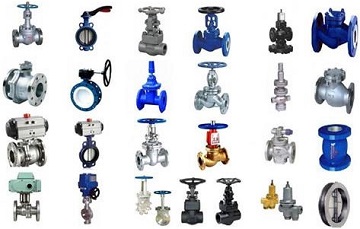Categories
- Pipe & Tube (18)
- Flange & Fitting (97)
- Fastener & Gasket (12)
- Valve & Pump (18)
- Base Material (11)
- Equipment (8)
- Application (30)
- Technical (110)
By definition, a valve is a device that controls the flow of a fluid. To be specific, it is a mechanical device designed to direct, start, stop, mix, or regulate the flow, pressure, or temperature of a process fluid. The “fluid” handled by a valve may be air, water, vapor, corrosive chemicals, slurry, oil, gas, liquid metal, powder, slag or other dry materials, etc. By driving its closure member to go up and down, slide, rotate, or swing, the valve can change its flow passage area to control the flow of the fluid.

miscellaneous valves
Valves are widely used in various pipeline and piping applications covering oil & gas industry, chemical industry, power plant, pulp and paper, food and beverage, nuclear, offshore and marine, aerospace and aviation, water supply, sewage treatment, and other civil projects, etc. Generally, different valves can be applied to a wide range of working pressures from 1.3 x 10-3 MPa to 1000 MPa with working temperatures ranging from -269°C to 1430°C.
The valve itself consists of a body (cast, forged or machined from bar stock) with pipe nozzles (welded, flanged, threaded, or made of specialty fittings), a bonnet (welded, bolted or threaded to the body), a closure member (a flat disc, a piston, a cylindrical or tapered plug, or a ball), a seat (against which the closure member will close), a stem (a stick) connecting the closure member to an actuator, and the actuator (a hand wheel, an air operated diaphragm, a hydraulic piston, or an electric motor, used to move the stem). The wetted parts of the valve, other than the body, are the valve trims: seat, disc, stem, packing, gasket, diaphragm, etc.
Valves can be designed and manufactured in accordance with a variety of major standards and Codes including ISO & EN; BS (UK); DIN (Germany); NF (France); JIS & JPI (Japan); GOST (Russia); ASTM, ASME, API, ANSI, MSS, AWWA, MIL (US); HG, HG/T, SH, JB/TQ (China). In addition, many major oil & gas companies as well as multinational contractors may establish their own criteria.
Valves can be classified in many ways. One typical way to classify valves is according to its operation method. If the movement of the closure member is driven by the fluid flowing through the valve or its internal mechanism, such as in check valve and safety relief valve, the valve is called an automated valve or automatic valve. If the movement of the closure member is driven by an external actuator, such as handle lever, wheel, worm gear, or pneumatic/ hydraulic/ electric actuator, the valve is called an actuated valve.
Valves can also be classified according to function: on-off valves, which handle the function of blocking the flow or allowing it to pass; non-return valves, which only allow flow to travel in one direction; throttling valves, which allow for regulation of the flow at any point between fully open to fully closed. Especially, a prevalent and universal way to classify valves is according to both function and valve-body construction: ball valve, plug valve, gate valve, globe valve, butterfly valve, check valve, safety relief valve, steam trap, diaphragm valve, and throttling valve, etc.
Valve classification according to nominal size: small-size valve (≤ DN 40); medium-size valve (DN 50 ~ DN 300); large-size valve (DN 350 ~ DN 1200); super large-size valve (≥ DN 1400). Valve classification according to nominal pressure: vacuum valve (< 1 standard atmosphere); low-pressure valve (≤ PN 1.6 MPa); medium-pressure valve (PN 2.5 MPa ~ PN 6.4 MPa); high-pressure valve (PN 10.0 MPa ~ PN 80.0 MPa); ultra-high-pressure valve (> 100 MPa). Valve classification according to working temperatures: high-temperature valves (T > 450°C); medium-temperature valves (120°C ≤ T ≤ 450°C); room-temperature valves (-29°C ≤ T < 120°C); low-temperature valves (-100°C ≤ T < -29°C); ultra-cryogenic valves (T < -100°C).
Valves can also be classified according to the material they are made from: non-metallic valves such as PVC valve, ceramic valve; metal valves: cast iron valve, ductile cast iron valve, cast steel valve, copper alloy valve, nickel alloy valve, titanium alloy valve, stainless steel valve, alloy steel valve, forged steel valve; lined valves: lead-lined valve, PTFE-lined valve, ceramic-lined valve. Valve classification according to end connection types: flanged valves (RF or RTJ flanged); threaded valves (NPT or BSPT end); butt welding or socket welding valves; ferrule or grooved valves.
